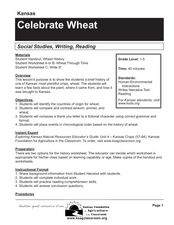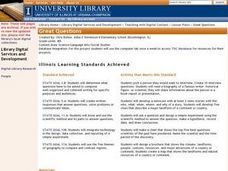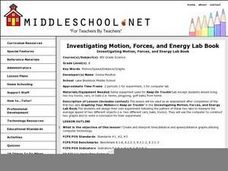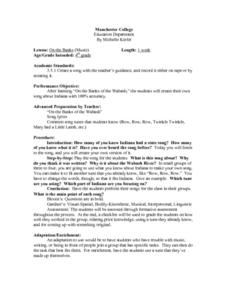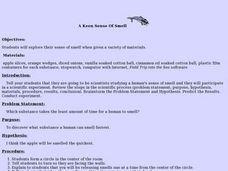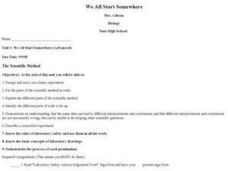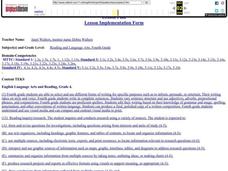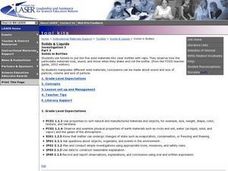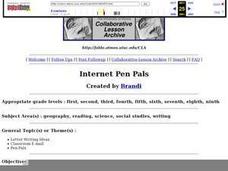Curated OER
Celebrate Wheat
Young scholars compose a thank you letter and a time line about the history of wheat. In this wheat lesson plan, students learn and discuss the origin of wheat, and the differences between einkorn, emmer, and wheat.
Curated OER
Great Questions
Fourth graders research and create questions about a famous person. They create questions in a game format, create a computer generated brochure, and develop rubrics for their finished projects.
Curated OER
Investigating Motion, Forces, and Energy Lab Book
Eighth graders create their own experiements using toy trucks, cars or balls to measure the time it takes two of them to travel 5 meters, as well as at each 1 meter interval. They make use computers to make a time/distance graph and...
Curated OER
The Class Garden Essay
Fifth graders use a class garden as inspiration for a specific writing assignment. They conduct research into different types of flowers in photo images taken with a digital camera. Students write a creative essay and draw a picture to...
Curated OER
The Effects of Volcanoes
Students use the internet to research the effects of volcanoes. They create a chart showing the negative and positive aspects that a volcanoe can bring to an area. Using PowerPoint, they create a presentation showing the negative and...
Curated OER
Bible: Righteous Anger
Students journal a prayer asking for forgiveness for a time when they became righteously angry. In this righteous anger instructional activity, students discuss Bible verses discussing reasons that anger can be righteous, using...
Curated OER
On The Banks
Fourth graders write and perform an original song about Indiana. After learning the lyrics of the song "On the Banks of the Wabash," students write lyrics to their own song about Indiana with assistance from the instructor. They...
Curated OER
Seeing/Reading Photographs Lesson Plan: An Interactive History Discussion
Students analyze and read historic photographs. In this historic photographs lesson, students explore history and writing by looking at photographs. Students discuss the photographs and produce a written record of the historical photograph.
Curated OER
Let Me Convince You
Pupils discuss the purposes of persuasive speaking and writing with emphasis upon what makes them different from other kinds. They brainstorm and discuss ways to select "The Greatest American Who Ever Lived" and prepare a persuasive on...
NASA
Producers Make Their Own Food
During an inquiry-based lesson, scholars decide which variable to test and then design an experiment to determine the needs of producers. After two weeks, they complete a full analysis and research paper.
Curated OER
A Keen Sense of Smell
Students investigate their sense of smell by experimenting with smelly objects. In this human senses instructional activity, students examine the length of time it takes to smell a random object that is close to them....
Curated OER
Sound All Around Us
Students make predictions about how sound is formed. They view and discuss a video that explores sound formation and attempt to identify the origin of different sounds.
Curated OER
How Do You Know There is Air in a Bag?
Fourth graders explore air as a material substance. Through experimentation and discussion, they explore how air can be classified as a material substance. Students write three examples proving that air is a material substance in their...
Curated OER
Using Representations to Model Problems
student make predictions or draw conclusions based on physical and visual representations of profit and sales. They model problems with physical materials and visual representations, and use models, graphs and tables to draw conclusions...
Curated OER
We All Start Somewhere
Students demonstrate an understanding that the same data can lead to different interpretations and conclusions and that different interpretations and conclusions are not necessarily wrong, but can be useful in developing other scientific...
Curated OER
Where Did It Begin?
Young scholars work together to research the oldest forms of writing in the world and the materials used to create them. They explore the cultures that used this early form of writing and draw conclusions about why specific symbols were...
Curated OER
MT-A141 PreCalculus: Worksheet 6.4
In this precalculus worksheet, students predict the graph of given functions and draw conclusions about each one. Students define a transformation, and determine the amplitude, period, phase shift and vertical shift of given problems. ...
Curated OER
Language Arts: Take Me to the Hall of Fame
Students write persuasive letters supporting a trip to the Baseball Hall of Fame. Once they have written the letter, they respond to it from the coach's point of view. In addition, students compose various conclusions to their letters.
Curated OER
My Metric System Smile
In this measurement learning exercise, students measure their smile and the smiles of people in their group using centimeters and millimeters. Students combine their data with their classmates' data to analyze and write a brief conclusion.
Curated OER
Owning a Pet
Fourth graders identify and use different forms of writing for various purposes. Using the internet, they read and gather information and write quesitons for their own investigations on the various pets they could own. They practice...
Curated OER
Solids in Bottles
Learners use funnels to put the five solid materials into clear bottles with caps. They observe how the particulate materials look, sound, and move when they shake and roll the bottle. Finally, students write "sound and touch" poetry.
Curated OER
Reporting Live From...
Students examine the many disasters in West Virginia. In this US history lesson, students write about and give an oral presentation of one of the disasters as if they were reporters.
Curated OER
Internet Pen Pals
Students write letters to e-mail pals and respond to letters received. Students describe the geography of their community to their pals.
Curated OER
Va Va Va Zoooommm
Students, in groups, measure a variety of physical components to several activities. They use both standard and non-standard forms of measurement and then develop conclusions about the use of units in measurement.


